Comparative Analysis: Obesity in Primary Health Care (Australia & USA)
VerifiedAdded on 2023/06/08
|9
|2422
|349
Report
AI Summary
This report provides a comparative analysis of the issue of obesity within primary health care in Australia and the United States of America. It examines the impact of obesity at community, population, and global levels, highlighting key strategies employed by both countries, such as health subsidy schemes and community-based programs, and compares their effectiveness. The report also delves into the application of the World Health Organization's (WHO) five key principles of primary health care, the determinants of health, and the epidemiological factors associated with obesity. Furthermore, it explores the crucial role and responsibilities of nurses in obesity management, including health promotion, education, and community development, providing insights into how healthcare professionals address this significant public health challenge. The report also considers factors like equity and social justice and how they are addressed in the context of obesity prevention and management.
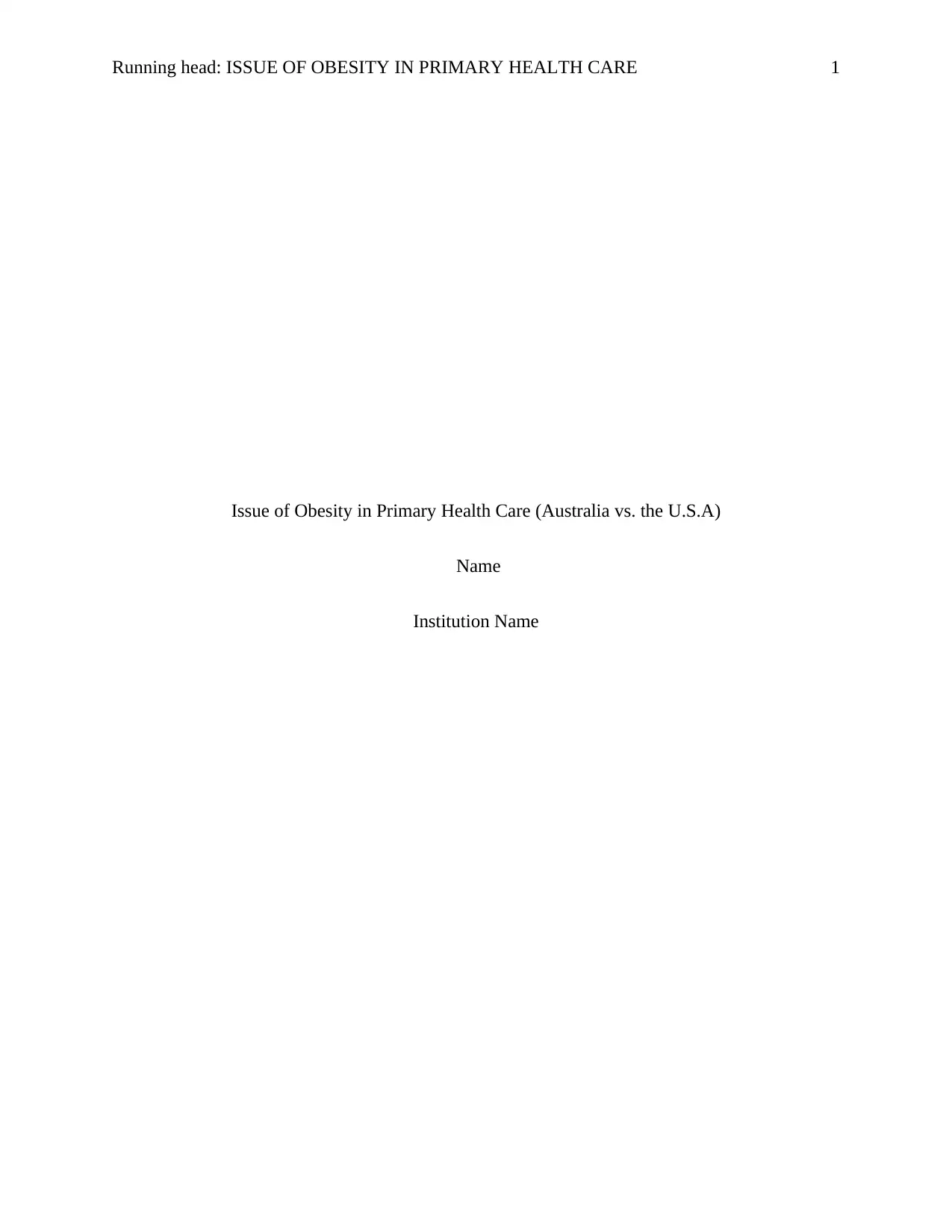
Running head: ISSUE OF OBESITY IN PRIMARY HEALTH CARE 1
Issue of Obesity in Primary Health Care (Australia vs. the U.S.A)
Name
Institution Name
Issue of Obesity in Primary Health Care (Australia vs. the U.S.A)
Name
Institution Name
Paraphrase This Document
Need a fresh take? Get an instant paraphrase of this document with our AI Paraphraser
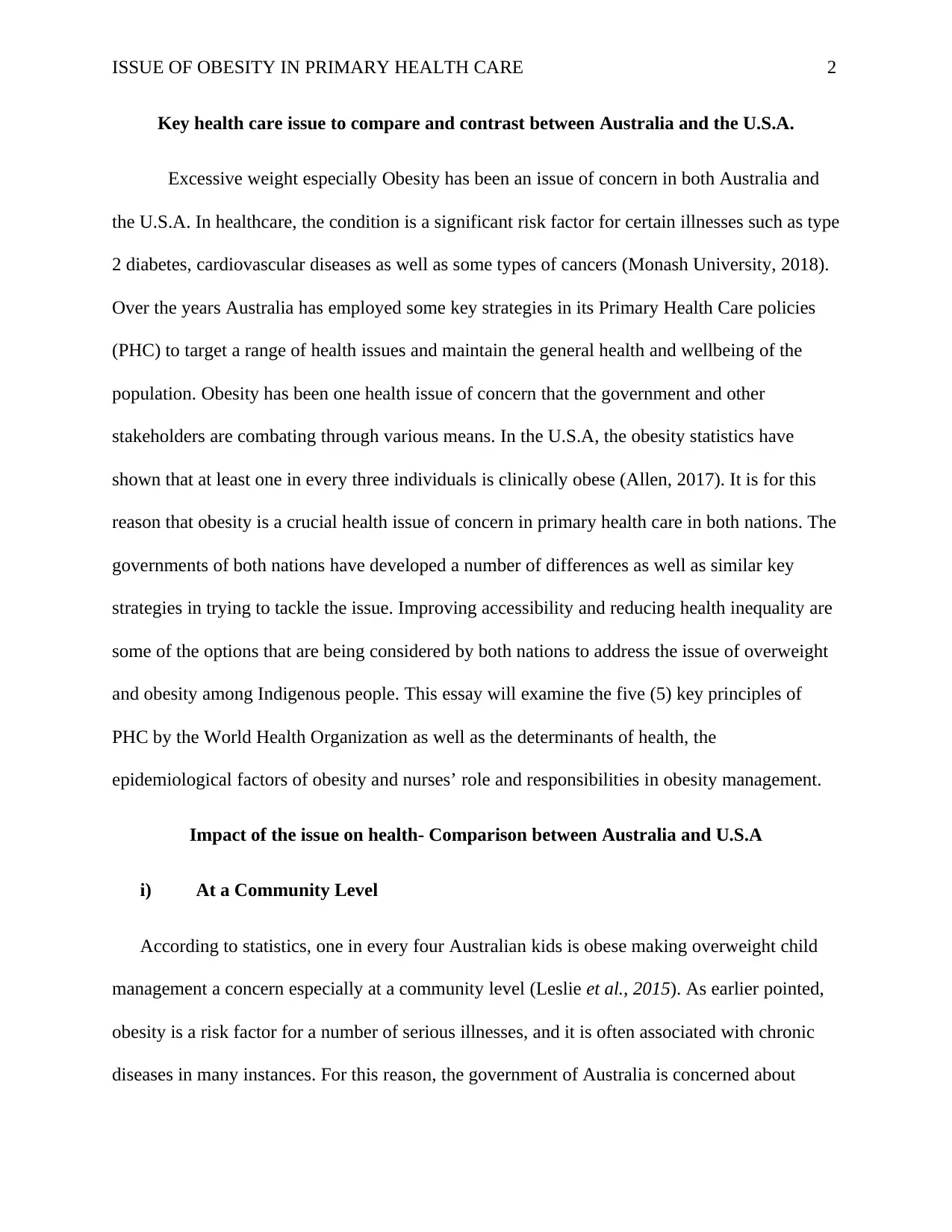
ISSUE OF OBESITY IN PRIMARY HEALTH CARE 2
Key health care issue to compare and contrast between Australia and the U.S.A.
Excessive weight especially Obesity has been an issue of concern in both Australia and
the U.S.A. In healthcare, the condition is a significant risk factor for certain illnesses such as type
2 diabetes, cardiovascular diseases as well as some types of cancers (Monash University, 2018).
Over the years Australia has employed some key strategies in its Primary Health Care policies
(PHC) to target a range of health issues and maintain the general health and wellbeing of the
population. Obesity has been one health issue of concern that the government and other
stakeholders are combating through various means. In the U.S.A, the obesity statistics have
shown that at least one in every three individuals is clinically obese (Allen, 2017). It is for this
reason that obesity is a crucial health issue of concern in primary health care in both nations. The
governments of both nations have developed a number of differences as well as similar key
strategies in trying to tackle the issue. Improving accessibility and reducing health inequality are
some of the options that are being considered by both nations to address the issue of overweight
and obesity among Indigenous people. This essay will examine the five (5) key principles of
PHC by the World Health Organization as well as the determinants of health, the
epidemiological factors of obesity and nurses’ role and responsibilities in obesity management.
Impact of the issue on health- Comparison between Australia and U.S.A
i) At a Community Level
According to statistics, one in every four Australian kids is obese making overweight child
management a concern especially at a community level (Leslie et al., 2015). As earlier pointed,
obesity is a risk factor for a number of serious illnesses, and it is often associated with chronic
diseases in many instances. For this reason, the government of Australia is concerned about
Key health care issue to compare and contrast between Australia and the U.S.A.
Excessive weight especially Obesity has been an issue of concern in both Australia and
the U.S.A. In healthcare, the condition is a significant risk factor for certain illnesses such as type
2 diabetes, cardiovascular diseases as well as some types of cancers (Monash University, 2018).
Over the years Australia has employed some key strategies in its Primary Health Care policies
(PHC) to target a range of health issues and maintain the general health and wellbeing of the
population. Obesity has been one health issue of concern that the government and other
stakeholders are combating through various means. In the U.S.A, the obesity statistics have
shown that at least one in every three individuals is clinically obese (Allen, 2017). It is for this
reason that obesity is a crucial health issue of concern in primary health care in both nations. The
governments of both nations have developed a number of differences as well as similar key
strategies in trying to tackle the issue. Improving accessibility and reducing health inequality are
some of the options that are being considered by both nations to address the issue of overweight
and obesity among Indigenous people. This essay will examine the five (5) key principles of
PHC by the World Health Organization as well as the determinants of health, the
epidemiological factors of obesity and nurses’ role and responsibilities in obesity management.
Impact of the issue on health- Comparison between Australia and U.S.A
i) At a Community Level
According to statistics, one in every four Australian kids is obese making overweight child
management a concern especially at a community level (Leslie et al., 2015). As earlier pointed,
obesity is a risk factor for a number of serious illnesses, and it is often associated with chronic
diseases in many instances. For this reason, the government of Australia is concerned about
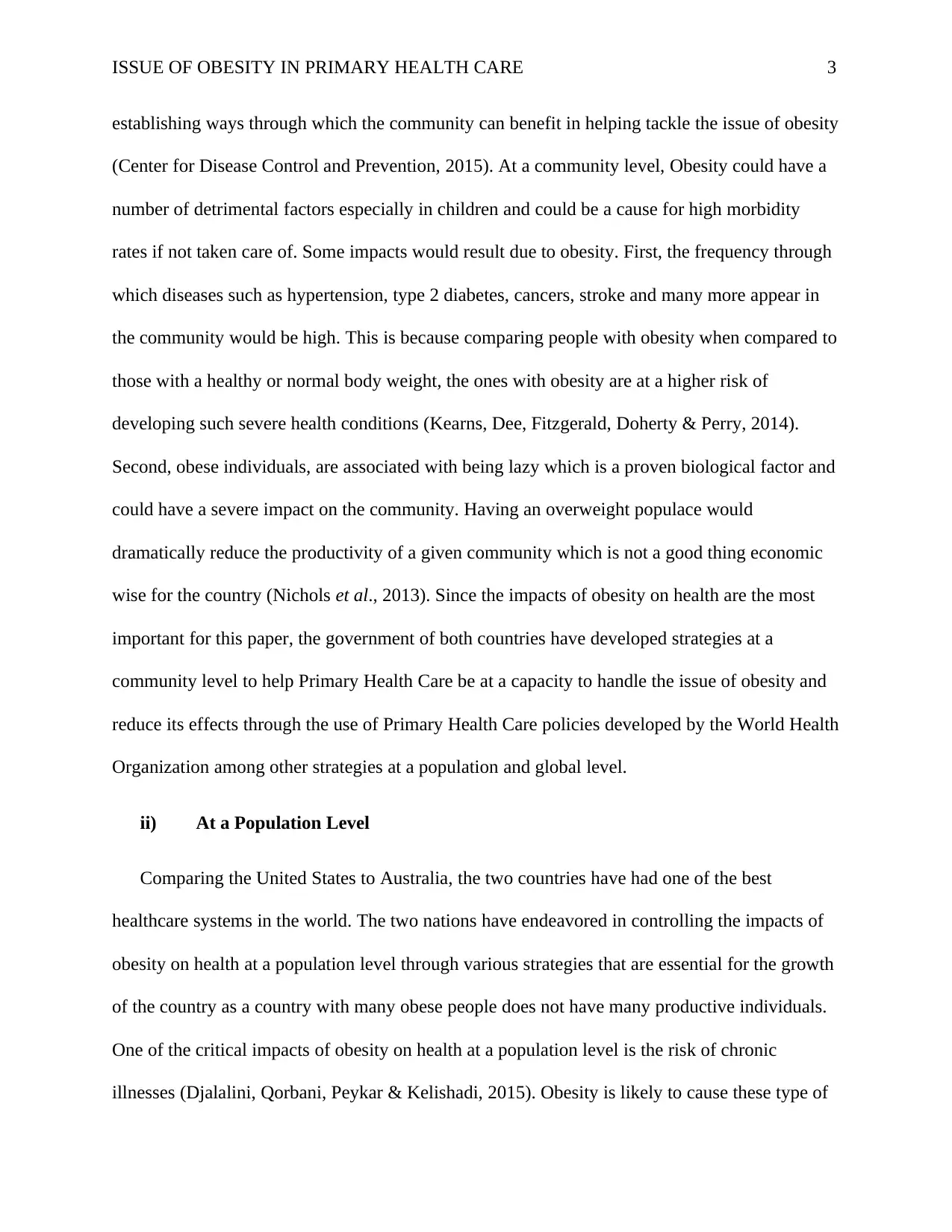
ISSUE OF OBESITY IN PRIMARY HEALTH CARE 3
establishing ways through which the community can benefit in helping tackle the issue of obesity
(Center for Disease Control and Prevention, 2015). At a community level, Obesity could have a
number of detrimental factors especially in children and could be a cause for high morbidity
rates if not taken care of. Some impacts would result due to obesity. First, the frequency through
which diseases such as hypertension, type 2 diabetes, cancers, stroke and many more appear in
the community would be high. This is because comparing people with obesity when compared to
those with a healthy or normal body weight, the ones with obesity are at a higher risk of
developing such severe health conditions (Kearns, Dee, Fitzgerald, Doherty & Perry, 2014).
Second, obese individuals, are associated with being lazy which is a proven biological factor and
could have a severe impact on the community. Having an overweight populace would
dramatically reduce the productivity of a given community which is not a good thing economic
wise for the country (Nichols et al., 2013). Since the impacts of obesity on health are the most
important for this paper, the government of both countries have developed strategies at a
community level to help Primary Health Care be at a capacity to handle the issue of obesity and
reduce its effects through the use of Primary Health Care policies developed by the World Health
Organization among other strategies at a population and global level.
ii) At a Population Level
Comparing the United States to Australia, the two countries have had one of the best
healthcare systems in the world. The two nations have endeavored in controlling the impacts of
obesity on health at a population level through various strategies that are essential for the growth
of the country as a country with many obese people does not have many productive individuals.
One of the critical impacts of obesity on health at a population level is the risk of chronic
illnesses (Djalalini, Qorbani, Peykar & Kelishadi, 2015). Obesity is likely to cause these type of
establishing ways through which the community can benefit in helping tackle the issue of obesity
(Center for Disease Control and Prevention, 2015). At a community level, Obesity could have a
number of detrimental factors especially in children and could be a cause for high morbidity
rates if not taken care of. Some impacts would result due to obesity. First, the frequency through
which diseases such as hypertension, type 2 diabetes, cancers, stroke and many more appear in
the community would be high. This is because comparing people with obesity when compared to
those with a healthy or normal body weight, the ones with obesity are at a higher risk of
developing such severe health conditions (Kearns, Dee, Fitzgerald, Doherty & Perry, 2014).
Second, obese individuals, are associated with being lazy which is a proven biological factor and
could have a severe impact on the community. Having an overweight populace would
dramatically reduce the productivity of a given community which is not a good thing economic
wise for the country (Nichols et al., 2013). Since the impacts of obesity on health are the most
important for this paper, the government of both countries have developed strategies at a
community level to help Primary Health Care be at a capacity to handle the issue of obesity and
reduce its effects through the use of Primary Health Care policies developed by the World Health
Organization among other strategies at a population and global level.
ii) At a Population Level
Comparing the United States to Australia, the two countries have had one of the best
healthcare systems in the world. The two nations have endeavored in controlling the impacts of
obesity on health at a population level through various strategies that are essential for the growth
of the country as a country with many obese people does not have many productive individuals.
One of the critical impacts of obesity on health at a population level is the risk of chronic
illnesses (Djalalini, Qorbani, Peykar & Kelishadi, 2015). Obesity is likely to cause these type of
⊘ This is a preview!⊘
Do you want full access?
Subscribe today to unlock all pages.

Trusted by 1+ million students worldwide
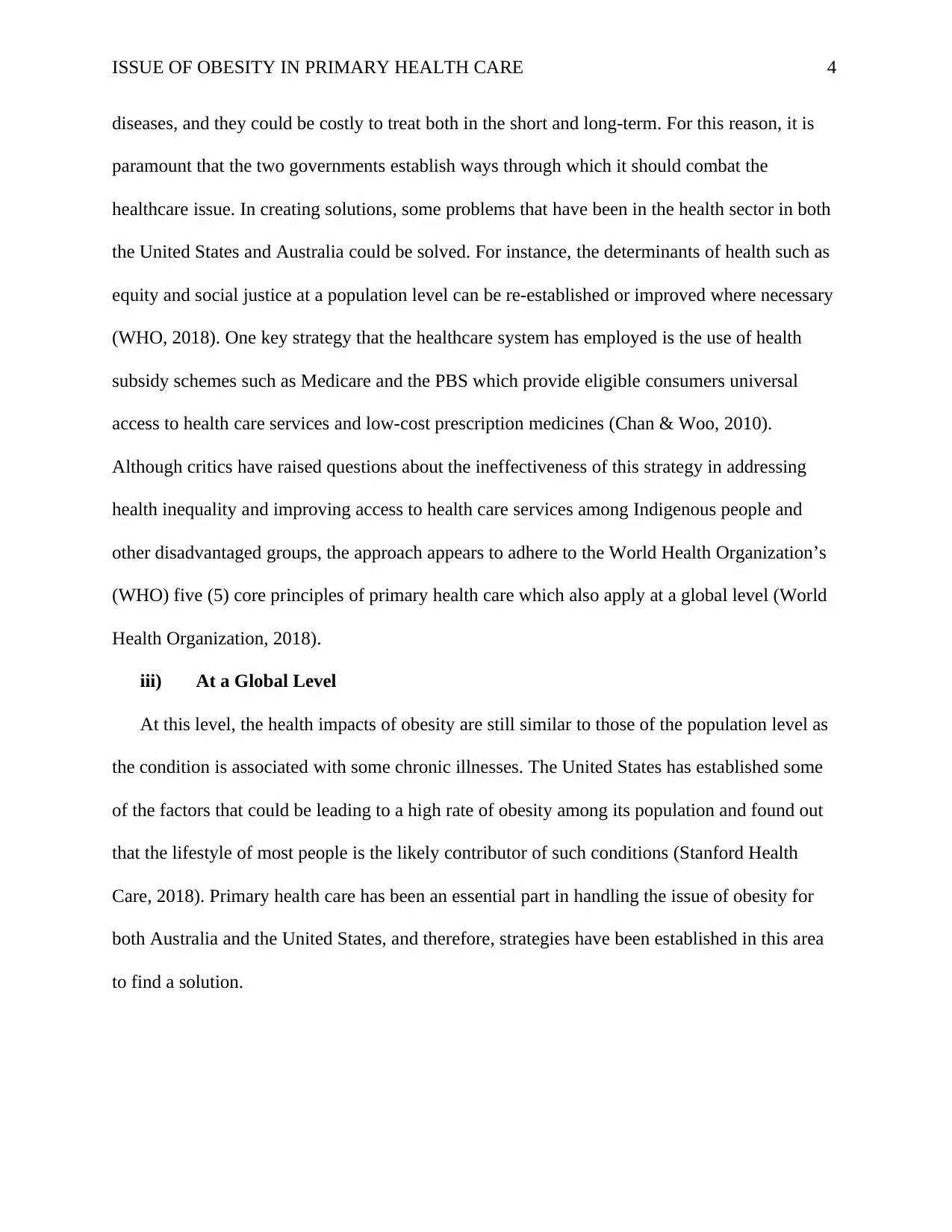
ISSUE OF OBESITY IN PRIMARY HEALTH CARE 4
diseases, and they could be costly to treat both in the short and long-term. For this reason, it is
paramount that the two governments establish ways through which it should combat the
healthcare issue. In creating solutions, some problems that have been in the health sector in both
the United States and Australia could be solved. For instance, the determinants of health such as
equity and social justice at a population level can be re-established or improved where necessary
(WHO, 2018). One key strategy that the healthcare system has employed is the use of health
subsidy schemes such as Medicare and the PBS which provide eligible consumers universal
access to health care services and low-cost prescription medicines (Chan & Woo, 2010).
Although critics have raised questions about the ineffectiveness of this strategy in addressing
health inequality and improving access to health care services among Indigenous people and
other disadvantaged groups, the approach appears to adhere to the World Health Organization’s
(WHO) five (5) core principles of primary health care which also apply at a global level (World
Health Organization, 2018).
iii) At a Global Level
At this level, the health impacts of obesity are still similar to those of the population level as
the condition is associated with some chronic illnesses. The United States has established some
of the factors that could be leading to a high rate of obesity among its population and found out
that the lifestyle of most people is the likely contributor of such conditions (Stanford Health
Care, 2018). Primary health care has been an essential part in handling the issue of obesity for
both Australia and the United States, and therefore, strategies have been established in this area
to find a solution.
diseases, and they could be costly to treat both in the short and long-term. For this reason, it is
paramount that the two governments establish ways through which it should combat the
healthcare issue. In creating solutions, some problems that have been in the health sector in both
the United States and Australia could be solved. For instance, the determinants of health such as
equity and social justice at a population level can be re-established or improved where necessary
(WHO, 2018). One key strategy that the healthcare system has employed is the use of health
subsidy schemes such as Medicare and the PBS which provide eligible consumers universal
access to health care services and low-cost prescription medicines (Chan & Woo, 2010).
Although critics have raised questions about the ineffectiveness of this strategy in addressing
health inequality and improving access to health care services among Indigenous people and
other disadvantaged groups, the approach appears to adhere to the World Health Organization’s
(WHO) five (5) core principles of primary health care which also apply at a global level (World
Health Organization, 2018).
iii) At a Global Level
At this level, the health impacts of obesity are still similar to those of the population level as
the condition is associated with some chronic illnesses. The United States has established some
of the factors that could be leading to a high rate of obesity among its population and found out
that the lifestyle of most people is the likely contributor of such conditions (Stanford Health
Care, 2018). Primary health care has been an essential part in handling the issue of obesity for
both Australia and the United States, and therefore, strategies have been established in this area
to find a solution.
Paraphrase This Document
Need a fresh take? Get an instant paraphrase of this document with our AI Paraphraser
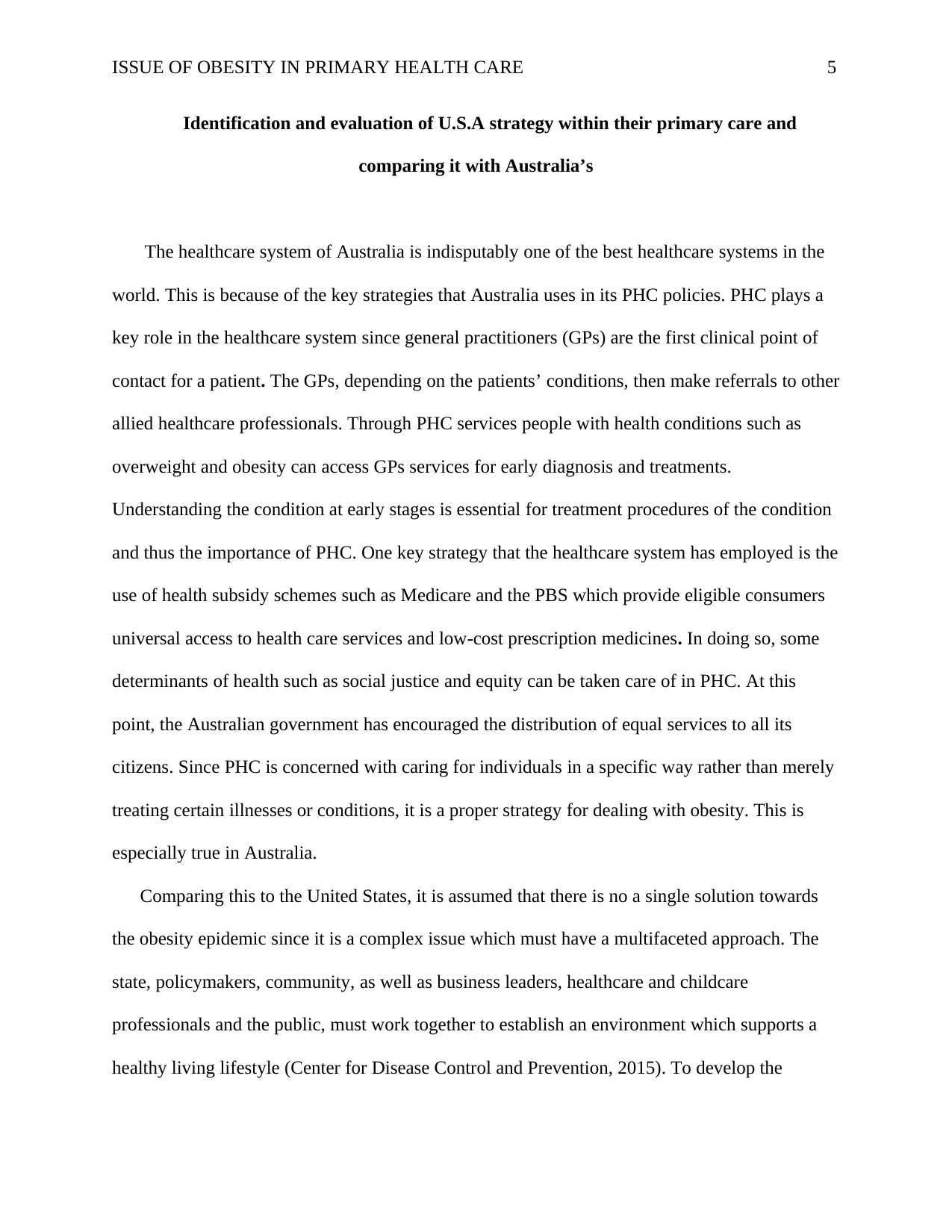
ISSUE OF OBESITY IN PRIMARY HEALTH CARE 5
Identification and evaluation of U.S.A strategy within their primary care and
comparing it with Australia’s
The healthcare system of Australia is indisputably one of the best healthcare systems in the
world. This is because of the key strategies that Australia uses in its PHC policies. PHC plays a
key role in the healthcare system since general practitioners (GPs) are the first clinical point of
contact for a patient. The GPs, depending on the patients’ conditions, then make referrals to other
allied healthcare professionals. Through PHC services people with health conditions such as
overweight and obesity can access GPs services for early diagnosis and treatments.
Understanding the condition at early stages is essential for treatment procedures of the condition
and thus the importance of PHC. One key strategy that the healthcare system has employed is the
use of health subsidy schemes such as Medicare and the PBS which provide eligible consumers
universal access to health care services and low-cost prescription medicines. In doing so, some
determinants of health such as social justice and equity can be taken care of in PHC. At this
point, the Australian government has encouraged the distribution of equal services to all its
citizens. Since PHC is concerned with caring for individuals in a specific way rather than merely
treating certain illnesses or conditions, it is a proper strategy for dealing with obesity. This is
especially true in Australia.
Comparing this to the United States, it is assumed that there is no a single solution towards
the obesity epidemic since it is a complex issue which must have a multifaceted approach. The
state, policymakers, community, as well as business leaders, healthcare and childcare
professionals and the public, must work together to establish an environment which supports a
healthy living lifestyle (Center for Disease Control and Prevention, 2015). To develop the
Identification and evaluation of U.S.A strategy within their primary care and
comparing it with Australia’s
The healthcare system of Australia is indisputably one of the best healthcare systems in the
world. This is because of the key strategies that Australia uses in its PHC policies. PHC plays a
key role in the healthcare system since general practitioners (GPs) are the first clinical point of
contact for a patient. The GPs, depending on the patients’ conditions, then make referrals to other
allied healthcare professionals. Through PHC services people with health conditions such as
overweight and obesity can access GPs services for early diagnosis and treatments.
Understanding the condition at early stages is essential for treatment procedures of the condition
and thus the importance of PHC. One key strategy that the healthcare system has employed is the
use of health subsidy schemes such as Medicare and the PBS which provide eligible consumers
universal access to health care services and low-cost prescription medicines. In doing so, some
determinants of health such as social justice and equity can be taken care of in PHC. At this
point, the Australian government has encouraged the distribution of equal services to all its
citizens. Since PHC is concerned with caring for individuals in a specific way rather than merely
treating certain illnesses or conditions, it is a proper strategy for dealing with obesity. This is
especially true in Australia.
Comparing this to the United States, it is assumed that there is no a single solution towards
the obesity epidemic since it is a complex issue which must have a multifaceted approach. The
state, policymakers, community, as well as business leaders, healthcare and childcare
professionals and the public, must work together to establish an environment which supports a
healthy living lifestyle (Center for Disease Control and Prevention, 2015). To develop the
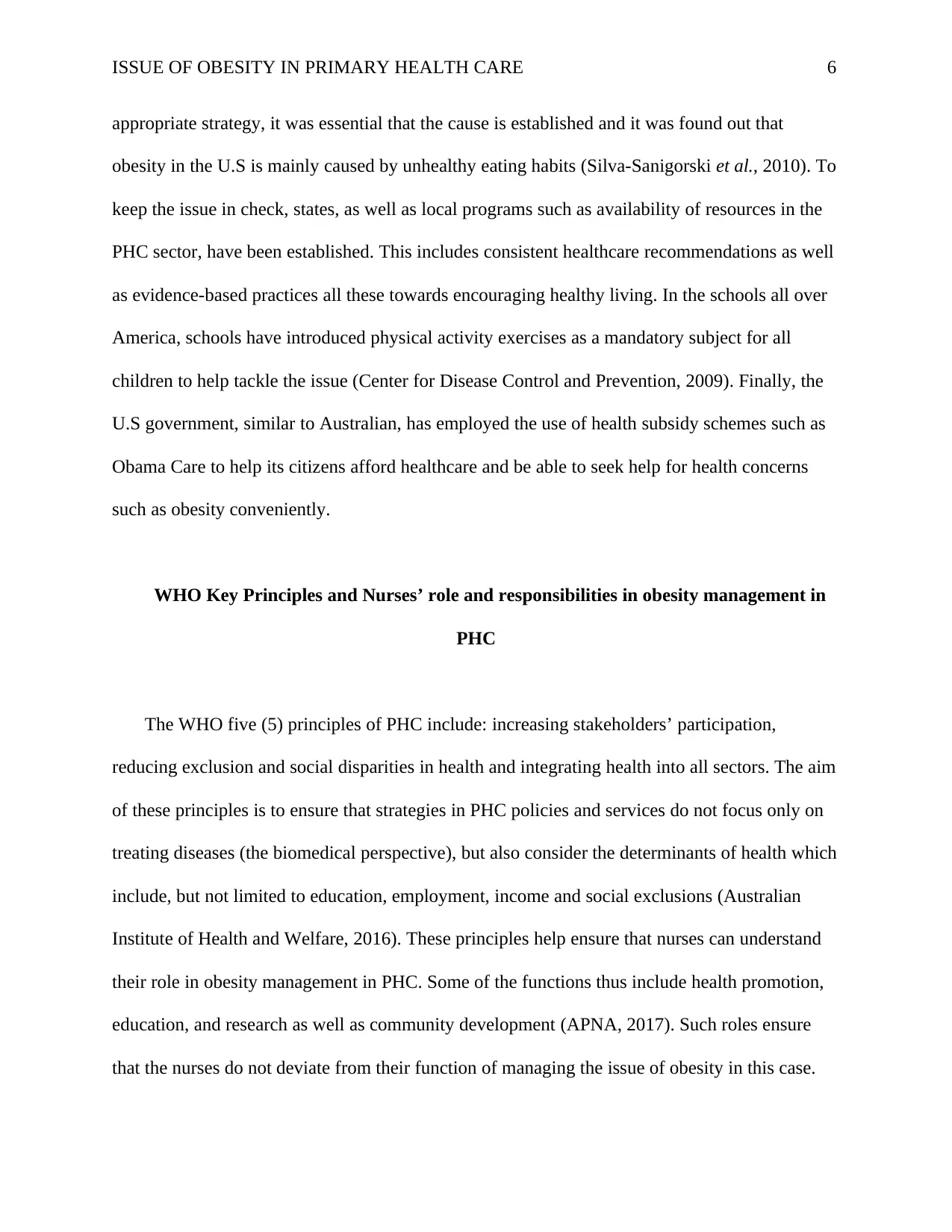
ISSUE OF OBESITY IN PRIMARY HEALTH CARE 6
appropriate strategy, it was essential that the cause is established and it was found out that
obesity in the U.S is mainly caused by unhealthy eating habits (Silva-Sanigorski et al., 2010). To
keep the issue in check, states, as well as local programs such as availability of resources in the
PHC sector, have been established. This includes consistent healthcare recommendations as well
as evidence-based practices all these towards encouraging healthy living. In the schools all over
America, schools have introduced physical activity exercises as a mandatory subject for all
children to help tackle the issue (Center for Disease Control and Prevention, 2009). Finally, the
U.S government, similar to Australian, has employed the use of health subsidy schemes such as
Obama Care to help its citizens afford healthcare and be able to seek help for health concerns
such as obesity conveniently.
WHO Key Principles and Nurses’ role and responsibilities in obesity management in
PHC
The WHO five (5) principles of PHC include: increasing stakeholders’ participation,
reducing exclusion and social disparities in health and integrating health into all sectors. The aim
of these principles is to ensure that strategies in PHC policies and services do not focus only on
treating diseases (the biomedical perspective), but also consider the determinants of health which
include, but not limited to education, employment, income and social exclusions (Australian
Institute of Health and Welfare, 2016). These principles help ensure that nurses can understand
their role in obesity management in PHC. Some of the functions thus include health promotion,
education, and research as well as community development (APNA, 2017). Such roles ensure
that the nurses do not deviate from their function of managing the issue of obesity in this case.
appropriate strategy, it was essential that the cause is established and it was found out that
obesity in the U.S is mainly caused by unhealthy eating habits (Silva-Sanigorski et al., 2010). To
keep the issue in check, states, as well as local programs such as availability of resources in the
PHC sector, have been established. This includes consistent healthcare recommendations as well
as evidence-based practices all these towards encouraging healthy living. In the schools all over
America, schools have introduced physical activity exercises as a mandatory subject for all
children to help tackle the issue (Center for Disease Control and Prevention, 2009). Finally, the
U.S government, similar to Australian, has employed the use of health subsidy schemes such as
Obama Care to help its citizens afford healthcare and be able to seek help for health concerns
such as obesity conveniently.
WHO Key Principles and Nurses’ role and responsibilities in obesity management in
PHC
The WHO five (5) principles of PHC include: increasing stakeholders’ participation,
reducing exclusion and social disparities in health and integrating health into all sectors. The aim
of these principles is to ensure that strategies in PHC policies and services do not focus only on
treating diseases (the biomedical perspective), but also consider the determinants of health which
include, but not limited to education, employment, income and social exclusions (Australian
Institute of Health and Welfare, 2016). These principles help ensure that nurses can understand
their role in obesity management in PHC. Some of the functions thus include health promotion,
education, and research as well as community development (APNA, 2017). Such roles ensure
that the nurses do not deviate from their function of managing the issue of obesity in this case.
⊘ This is a preview!⊘
Do you want full access?
Subscribe today to unlock all pages.

Trusted by 1+ million students worldwide
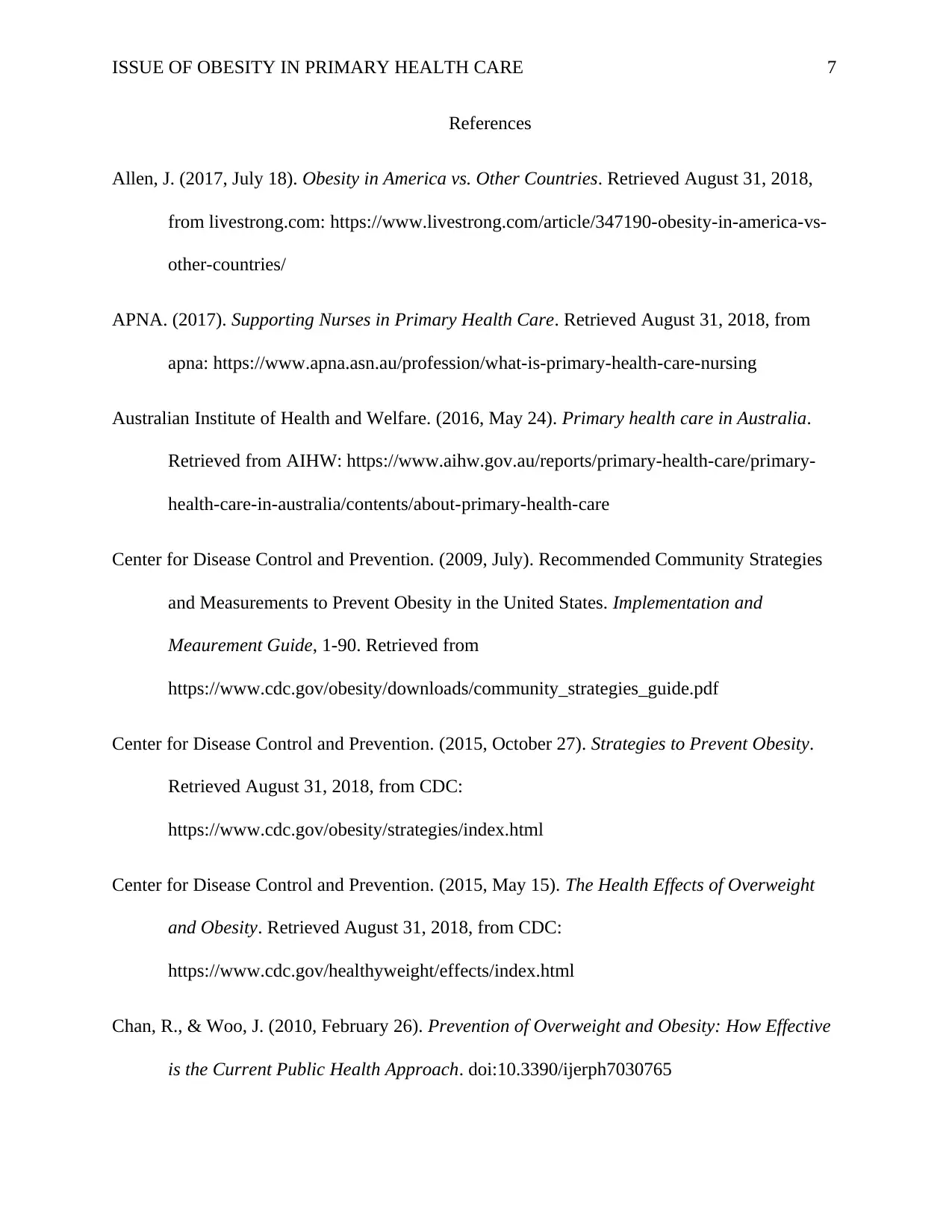
ISSUE OF OBESITY IN PRIMARY HEALTH CARE 7
References
Allen, J. (2017, July 18). Obesity in America vs. Other Countries. Retrieved August 31, 2018,
from livestrong.com: https://www.livestrong.com/article/347190-obesity-in-america-vs-
other-countries/
APNA. (2017). Supporting Nurses in Primary Health Care. Retrieved August 31, 2018, from
apna: https://www.apna.asn.au/profession/what-is-primary-health-care-nursing
Australian Institute of Health and Welfare. (2016, May 24). Primary health care in Australia.
Retrieved from AIHW: https://www.aihw.gov.au/reports/primary-health-care/primary-
health-care-in-australia/contents/about-primary-health-care
Center for Disease Control and Prevention. (2009, July). Recommended Community Strategies
and Measurements to Prevent Obesity in the United States. Implementation and
Meaurement Guide, 1-90. Retrieved from
https://www.cdc.gov/obesity/downloads/community_strategies_guide.pdf
Center for Disease Control and Prevention. (2015, October 27). Strategies to Prevent Obesity.
Retrieved August 31, 2018, from CDC:
https://www.cdc.gov/obesity/strategies/index.html
Center for Disease Control and Prevention. (2015, May 15). The Health Effects of Overweight
and Obesity. Retrieved August 31, 2018, from CDC:
https://www.cdc.gov/healthyweight/effects/index.html
Chan, R., & Woo, J. (2010, February 26). Prevention of Overweight and Obesity: How Effective
is the Current Public Health Approach. doi:10.3390/ijerph7030765
References
Allen, J. (2017, July 18). Obesity in America vs. Other Countries. Retrieved August 31, 2018,
from livestrong.com: https://www.livestrong.com/article/347190-obesity-in-america-vs-
other-countries/
APNA. (2017). Supporting Nurses in Primary Health Care. Retrieved August 31, 2018, from
apna: https://www.apna.asn.au/profession/what-is-primary-health-care-nursing
Australian Institute of Health and Welfare. (2016, May 24). Primary health care in Australia.
Retrieved from AIHW: https://www.aihw.gov.au/reports/primary-health-care/primary-
health-care-in-australia/contents/about-primary-health-care
Center for Disease Control and Prevention. (2009, July). Recommended Community Strategies
and Measurements to Prevent Obesity in the United States. Implementation and
Meaurement Guide, 1-90. Retrieved from
https://www.cdc.gov/obesity/downloads/community_strategies_guide.pdf
Center for Disease Control and Prevention. (2015, October 27). Strategies to Prevent Obesity.
Retrieved August 31, 2018, from CDC:
https://www.cdc.gov/obesity/strategies/index.html
Center for Disease Control and Prevention. (2015, May 15). The Health Effects of Overweight
and Obesity. Retrieved August 31, 2018, from CDC:
https://www.cdc.gov/healthyweight/effects/index.html
Chan, R., & Woo, J. (2010, February 26). Prevention of Overweight and Obesity: How Effective
is the Current Public Health Approach. doi:10.3390/ijerph7030765
Paraphrase This Document
Need a fresh take? Get an instant paraphrase of this document with our AI Paraphraser
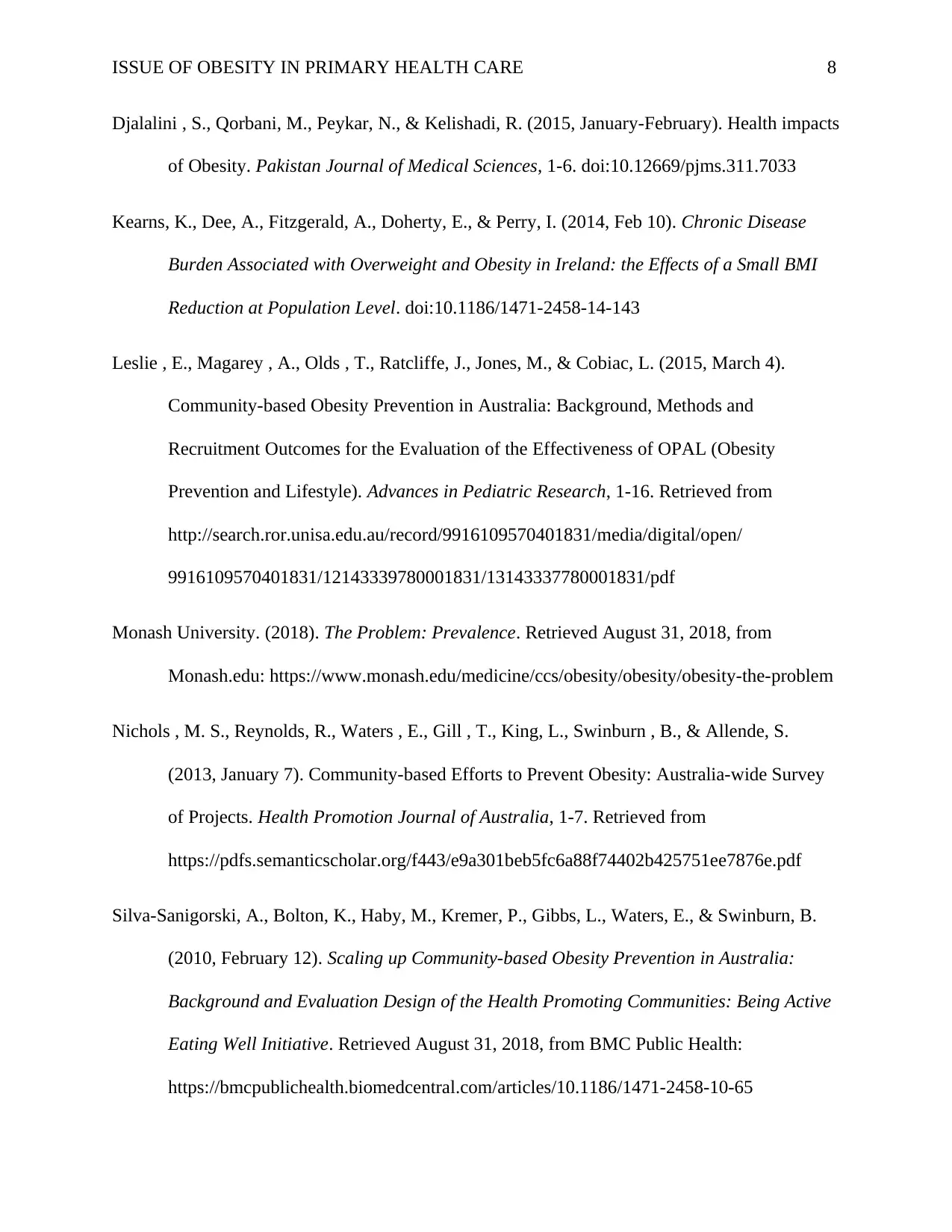
ISSUE OF OBESITY IN PRIMARY HEALTH CARE 8
Djalalini , S., Qorbani, M., Peykar, N., & Kelishadi, R. (2015, January-February). Health impacts
of Obesity. Pakistan Journal of Medical Sciences, 1-6. doi:10.12669/pjms.311.7033
Kearns, K., Dee, A., Fitzgerald, A., Doherty, E., & Perry, I. (2014, Feb 10). Chronic Disease
Burden Associated with Overweight and Obesity in Ireland: the Effects of a Small BMI
Reduction at Population Level. doi:10.1186/1471-2458-14-143
Leslie , E., Magarey , A., Olds , T., Ratcliffe, J., Jones, M., & Cobiac, L. (2015, March 4).
Community-based Obesity Prevention in Australia: Background, Methods and
Recruitment Outcomes for the Evaluation of the Effectiveness of OPAL (Obesity
Prevention and Lifestyle). Advances in Pediatric Research, 1-16. Retrieved from
http://search.ror.unisa.edu.au/record/9916109570401831/media/digital/open/
9916109570401831/12143339780001831/13143337780001831/pdf
Monash University. (2018). The Problem: Prevalence. Retrieved August 31, 2018, from
Monash.edu: https://www.monash.edu/medicine/ccs/obesity/obesity/obesity-the-problem
Nichols , M. S., Reynolds, R., Waters , E., Gill , T., King, L., Swinburn , B., & Allende, S.
(2013, January 7). Community-based Efforts to Prevent Obesity: Australia-wide Survey
of Projects. Health Promotion Journal of Australia, 1-7. Retrieved from
https://pdfs.semanticscholar.org/f443/e9a301beb5fc6a88f74402b425751ee7876e.pdf
Silva-Sanigorski, A., Bolton, K., Haby, M., Kremer, P., Gibbs, L., Waters, E., & Swinburn, B.
(2010, February 12). Scaling up Community-based Obesity Prevention in Australia:
Background and Evaluation Design of the Health Promoting Communities: Being Active
Eating Well Initiative. Retrieved August 31, 2018, from BMC Public Health:
https://bmcpublichealth.biomedcentral.com/articles/10.1186/1471-2458-10-65
Djalalini , S., Qorbani, M., Peykar, N., & Kelishadi, R. (2015, January-February). Health impacts
of Obesity. Pakistan Journal of Medical Sciences, 1-6. doi:10.12669/pjms.311.7033
Kearns, K., Dee, A., Fitzgerald, A., Doherty, E., & Perry, I. (2014, Feb 10). Chronic Disease
Burden Associated with Overweight and Obesity in Ireland: the Effects of a Small BMI
Reduction at Population Level. doi:10.1186/1471-2458-14-143
Leslie , E., Magarey , A., Olds , T., Ratcliffe, J., Jones, M., & Cobiac, L. (2015, March 4).
Community-based Obesity Prevention in Australia: Background, Methods and
Recruitment Outcomes for the Evaluation of the Effectiveness of OPAL (Obesity
Prevention and Lifestyle). Advances in Pediatric Research, 1-16. Retrieved from
http://search.ror.unisa.edu.au/record/9916109570401831/media/digital/open/
9916109570401831/12143339780001831/13143337780001831/pdf
Monash University. (2018). The Problem: Prevalence. Retrieved August 31, 2018, from
Monash.edu: https://www.monash.edu/medicine/ccs/obesity/obesity/obesity-the-problem
Nichols , M. S., Reynolds, R., Waters , E., Gill , T., King, L., Swinburn , B., & Allende, S.
(2013, January 7). Community-based Efforts to Prevent Obesity: Australia-wide Survey
of Projects. Health Promotion Journal of Australia, 1-7. Retrieved from
https://pdfs.semanticscholar.org/f443/e9a301beb5fc6a88f74402b425751ee7876e.pdf
Silva-Sanigorski, A., Bolton, K., Haby, M., Kremer, P., Gibbs, L., Waters, E., & Swinburn, B.
(2010, February 12). Scaling up Community-based Obesity Prevention in Australia:
Background and Evaluation Design of the Health Promoting Communities: Being Active
Eating Well Initiative. Retrieved August 31, 2018, from BMC Public Health:
https://bmcpublichealth.biomedcentral.com/articles/10.1186/1471-2458-10-65
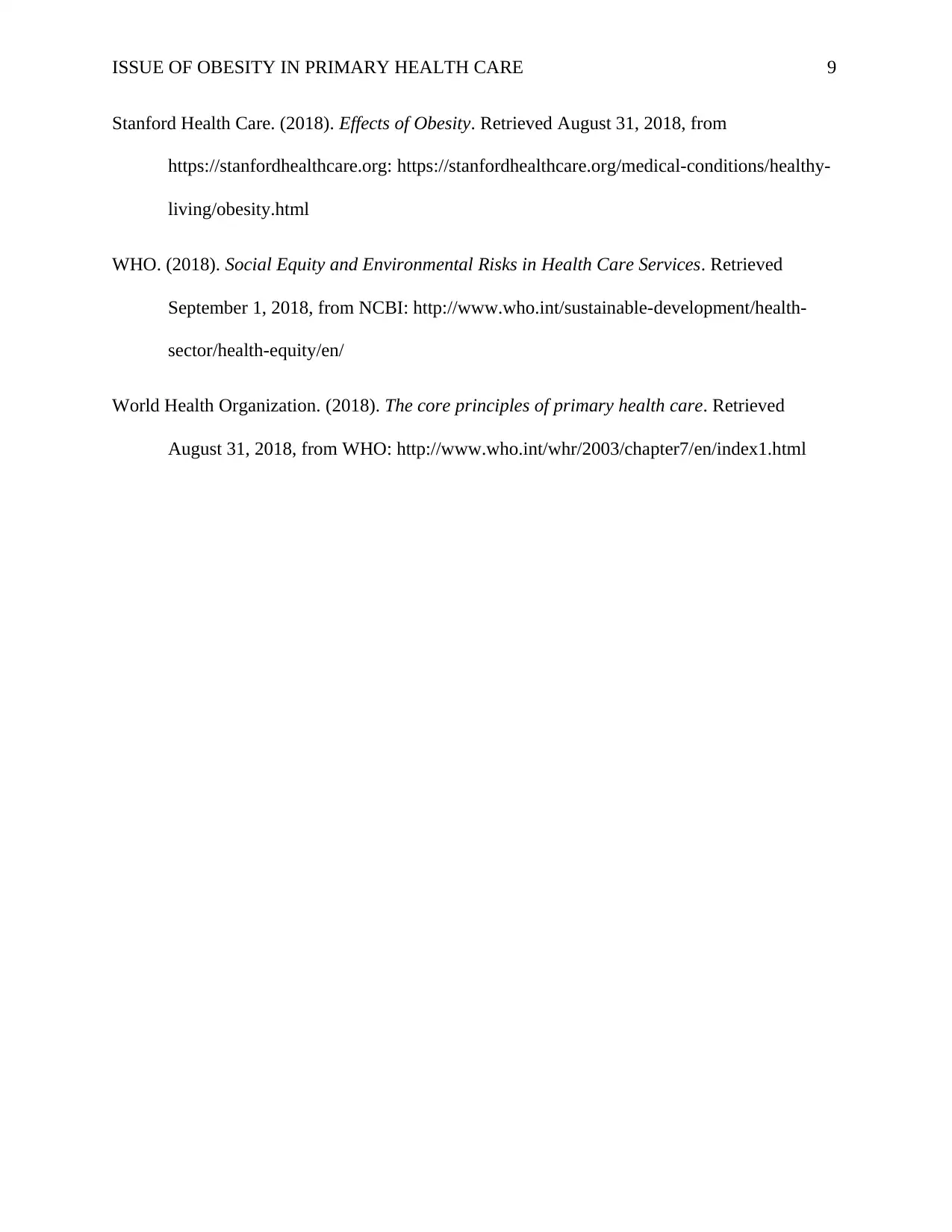
ISSUE OF OBESITY IN PRIMARY HEALTH CARE 9
Stanford Health Care. (2018). Effects of Obesity. Retrieved August 31, 2018, from
https://stanfordhealthcare.org: https://stanfordhealthcare.org/medical-conditions/healthy-
living/obesity.html
WHO. (2018). Social Equity and Environmental Risks in Health Care Services. Retrieved
September 1, 2018, from NCBI: http://www.who.int/sustainable-development/health-
sector/health-equity/en/
World Health Organization. (2018). The core principles of primary health care. Retrieved
August 31, 2018, from WHO: http://www.who.int/whr/2003/chapter7/en/index1.html
Stanford Health Care. (2018). Effects of Obesity. Retrieved August 31, 2018, from
https://stanfordhealthcare.org: https://stanfordhealthcare.org/medical-conditions/healthy-
living/obesity.html
WHO. (2018). Social Equity and Environmental Risks in Health Care Services. Retrieved
September 1, 2018, from NCBI: http://www.who.int/sustainable-development/health-
sector/health-equity/en/
World Health Organization. (2018). The core principles of primary health care. Retrieved
August 31, 2018, from WHO: http://www.who.int/whr/2003/chapter7/en/index1.html
⊘ This is a preview!⊘
Do you want full access?
Subscribe today to unlock all pages.

Trusted by 1+ million students worldwide
1 out of 9
Related Documents
Your All-in-One AI-Powered Toolkit for Academic Success.
+13062052269
info@desklib.com
Available 24*7 on WhatsApp / Email
![[object Object]](/_next/static/media/star-bottom.7253800d.svg)
Unlock your academic potential
Copyright © 2020–2025 A2Z Services. All Rights Reserved. Developed and managed by ZUCOL.



